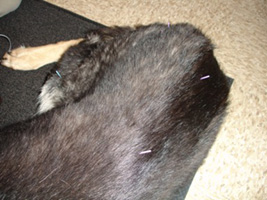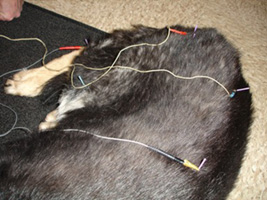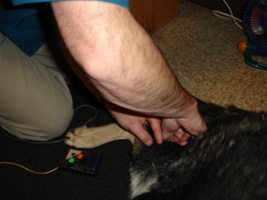We’re located in Union Grove, Wisconsin • Email: [email protected] • Call: (262) 994-3487 • Facebook
By Kathy Edstrom
A few years ago my oldest German shepherd dog, Banjo, was diagnosed with hip dysplasia. (A progressive degenerative condition of the pelvic joint that can lead to severe lameness and pain in large breed dogs. It can be very debilitating.) Hip dysplasia occurs when the head of the femur, the upper bone in the hind leg, does not fit into the socket, or acetabulum, of the joint properly.

I thought about all of the things that Banjo would no longer be able to do. I knew that I had to explore every option available to help my canine buddy live the remainder of his life as comfortable and pain-free as possible.
There are many drugs on the market to assist animals with alleviating pain. However, the majority of these medications also have side effects; some are even fatal! Banjo is approaching the age of 10, and I hope he still has a few years ahead of him to enjoy life within his limitations. Because of the potential side effects with so many of the pharmaceuticals that are used to treat hip dysplasia, I decided to explore more non-invasive therapies.

Besides HTA, Banjo receives acupuncture treatments every 5 to 6 weeks. Before I tried acupuncture with Banjo, I decided to go for an acupuncture treatment just so I could experience this modality. It also gave me an idea of the sensation Banjo might feel during his treatments.
My primary veterinarian was very supportive of my decision to not use drugs and to pursue acupuncture with Banjo. After Banjo’s first acupuncture treatment, we began to see some positive results. He had more energy, and was able to get up and move around more freely. It was obvious that acupuncture was helping to relieve the pain and discomfort in Banjo’s joints. Even though Banjo is getting older, and his age plays a major role in the severity of his hip dysplasia, we still continue to see favorable results with his on-going acupuncture treatments. He’s been receiving acupuncture since July 2001, and Banjo is still drug-free.

There is no such thing as the “placebo effect” with animals. If acupuncture were no longer helping Banjo, his behavior would change. Banjo continues to be quite “energized” after each treatment, and he is able to climb stairs, fetch sticks in the yard, and go for a nice swim on warm summer days. His appetite is just as good now as it was when Banjo was a puppy. I fully support acupuncture and the incredible effects it has on animals.
I am now going to introduce you to a fine veterinarian, Dr. Shawn Mulvihill. Banjo and I thank him for not only agreeing to be featured on the Paws-A-Tive Choice website, but for the excellent care he’s provided throughout each of Banjo’s acupuncture treatments.
Dr. Shawn Mulvihill
Dr. Shawn Mulvihill graduated in 1978 from Valparaiso University – Valparaiso, Indiana with a Bachelors of Science in Biology. He then worked for the University of Colorado Health Sciences Center as a Research Associate in the departments of Physiology and Clinical Sciences (Rheumatology) from 1980 to 1984. Dr. Mulvihill received his DVM from Colorado State University in 1988.
In 1997, Dr. Mulvihill became certified in Veterinary Chinese Herbology through the Healing Oasis Wellness Center and has advanced training in Western Herbal Medicine. (At this time, he is not currently certified through IVAS – International Veterinary Acupuncture Society).
Dr. Mulvihill has been married for 11 years to Stacey. They have 3 sons: Michael, age 9, Nathaniel, age 8, and Ian age 4. His family currently lives with 2 cats, a Scarlet Macaw, a ring-necked parrot, and a tank full of various fish. Dr. Mulvihill said at one time they had 9 large parrots, 2 dogs, 3 cats, 2 boa constrictors, multiple iguanas, a pink-toed tarantula, several guinea pigs: you get the idea. When Dr. Mulvihill is not caring for his clients’ pets, he enjoys hiking, canoeing, camping, visiting local museums, and generally keeps busy with his children’s school activities.
I asked Dr. Mulvihill what sparked his interest in holistic veterinary care. “I originally became interested in holistic veterinary practice when my wife and I had children of our own. We began incorporating things we had read about to minimize the damage that occurs to all of us just living in this day and age, such as homeopathy, organic foods and nutrition with our sons as they were growing up. This started me down the path and we have tried to continue that philosophy in our lives. It was logical that I would end up working at a holistic practice since it became too hard to continue practicing the old way for me.”
Dr. Mulvihill worked at a very busy, small animal practice in Valparaiso, Indiana for about 10 years, dealing with small animals and exotics before moving to Wisconsin to work at the Healing Oasis Veterinary Hospital, which is where he’s worked since 1998.
Even though his personal and professional life keep him quite busy, he took the time to get trained in acupuncture from Colorado State University in 2000 at their IVAS – Certification Eligible Course. His training involved 140 hours of classroom and practical teaching in veterinary acupuncture for both large and small animals at the Veterinary Teaching Hospitalin Fort Collins, Colorado. Dr. Mulvihill has been practicing acupuncture for about 3 years, as he said he started while he was still in training by doing some aquapuncture on his dogs and cats. More on “aquapuncture” shortly.
Because of his training in Traditional Chinese Medicine (TCM), he believed it was a logical addition to Chinese Herbology, as these are both part of the larger system of TCM.
What is acupuncture, and how does it work? Dr. Mulvihill shared his thoughts on this ancient healing modality. “Veterinary acupuncture is a system of treatment associated with TCM (Traditional Chinese Medicine) although some historians believe that it may have come from northern India or Tibet and spread to China where it was systemized. The points, channels, and laws associated with acupuncture were developed over many centuries by meticulous observation of the body and its interaction with nature. It has developed into a system by which needles are inserted at specific points on the body to prevent, diagnose, and treat disease. Acupuncture in China is actually used more in animals than in people, as human TCM is based more on herbal therapy and nutrition. Chinese medicine tends to use acupuncture in a more integrative way, seeing the body as being in balance when health is apparent and being in disharmony when dis-ease is apparent. We use prescribed points to return the body system to homeostasis by stimulating the bodies inherent healing mechanisms.”
Dr. Mulvihill went on to explain other theories. “There are many modern theories as to how and why acupuncture works and this has been the most studied alternative modality in the last 20 to 30 years. Some scientists postulate that pain mediators such as the body’s natural opiates (endorphins) are released when certain viscero-somatic nerve roots and ganglion are stimulated by needle placement. Additionally, there are local effects around the needle itself, which may block painful nerve impulses or stimulate others to promote healing. Research is ongoing and continues to show many other neurological, hormonal, and immune-mediating effects of acupuncture.”
So what physical ailments can be helped by acupuncture? According to Dr. Mulvihill, “Many disharmonies can be treated with acupuncture including, but not limited to, chronic pain, immune-mediated diseases, digestive problems, epilepsy and nervous system disease, hormonal imbalances, and recently, to reduce anesthetic use during surgical procedures. Most animals respond within 3 to 4 treatments. Patience is a necessary prerequisite when using this treatment method and commitment to a schedule is necessary to optimize results.”
Initial treatments generally require 30-45 minutes, although some of this time involves trying to get the client and patient in the proper state of mind and relaxation. Follow-up therapy usually takes 15-25 minutes. Some animals may not be amenable to acupuncture if they are too anxious or agitated initially. This often improves with experience with the procedure.
Dr. Mulvihill described the reaction that pets often have during an acupuncture treatment. “Many animals will ‘zone out’ after mild stimulation, others may salivate, pant, or experience a wide variety of sensations, as has been documented in human patients. Many will fall asleep during the procedure and often have increased energy immediately after the session. We warn all of our clients that some animals can be quite sore within the first 24 hours following treatment but usually feel better within 36 to 48 hours.”
How long will the effects from acupuncture last? This depends on the individual and the degree of imbalance or dis-ease present in the body. According to Dr. Mulvihill, “Often animals respond with the first treatment. Many require 3 to 4 treatments before positive results occur and rarely a few do not respond at all. After initial treatments, most patients with advanced arthritic disease, for example, can be maintained on 4 to 6 week schedules, sometimes alternating with chiropractic care.”
Dr. Mulvihill says he generally incorporates herbal medicine and nutrition, as these tend to work more deeply in the body and will always aid in improving the overall health and long-term quality of life in his patients. He also said Chiropractic care is commonly used between or concurrently with acupuncture as well as massage.
With Banjo, he receives Chiropractic adjustments as needed. In between his acupuncture treatments, I provide Healing Touch to aid in the relaxation process so Banjo’s body can continue to self-heal. (Please read Dr. Donald Stouffer’s article on Healing Touch: “Why Does Healing Touch Work?”)
Earlier, Dr. Mulvihill mentioned “aquapuncture” (injecting vitamin B-12 into the site where this procedure is to be performed). He also utilizes electroacupuncture when necessary. Dr. Mulvihill explained what the differences are. “These variations of dry needle acupuncture are often used in fractious animals when placing needles for 15 to 20 minutes is not practical, such as in many cats and birds or in very painful animals (aquapuncture). Electro acupuncture is commonly used to stimulate the area and the points more thoroughly and is helpful in relaxing painful, tight, or muscles that spasm. It usually provides more long-term relief in the chronically painful patient.”
What does electroacupuncture do? “Electroacupuncture directs a low voltage electrical current through the needles to provide greater stimulation and release of pain-mediating substances such as endorphins and encephlins. It also can be used to direct the flow of energy and stimulation between the set of needles used in the circuit.”
Why is Vitamin B-12 used? “Vitamin B-12 is used as an irritant at the acupuncture point to stimulate the region long after the needle has been removed. It is also coincidentally good for stimulating appetite, boosting the energy level of the body and is essential for hemoglobin production. It is generally always diluted in physiological saline to reduce the unpleasant stinging that can occur at full strength.”
Besides the many cases where acupuncture is used for chronic pain, Dr. Mulvihill said it has been useful in some kidney failure cats. He shared this brief case. “One cat named Oreo in particular was in the advanced stages of renal failure. He would lay down and almost fall asleep during his needling. It kept him eating and active for 5 to 6 months even though his lab values were at extremely toxic levels.”
When should a pet owner take her pet for acupuncture? The most common patients Dr. Mulvihill sees are usually animals with advanced arthritis or chronic pain. Most of these patients have not responded well to conventional treatment or cannot tolerate pharmaceuticals. He also sees patients with chronic immune system problems. Dr. Mulvihill advises acupuncture for those patients who are amenable to being needled only after their severe pain has been tempered somewhat by conventional or natural pain remedies. He said, “I don’t think any of us would appreciate having needles put in us if we had extremely tender or infected skin for one example. This modality may not be suitable for every animal, which is why we at our clinic advise clients that a thorough physical and history are necessary before treatment is initiated.”
Most species of domesticated animals including dogs, cats, horses, cattle, goats, & sheep can be treated using this modality. Dr. Mulvihill noted, “Birds and small exotics can also benefit although, different techniques such as laser therapy may be more practical.”
Most small animal sessions initially range $65 to $80 due to the need to do a thorough physical evaluation. Follow-up visits are between $45 and $60. Aquapuncture treatments are generally $30 to $45.
I asked Dr. Mulvihill to share any final thoughts he has on holistic care for people and their pets. “I truly believe that a more holistic approach to health will always lead to improved quality of life and greater satisfaction for both the pet and their human caregiver. There are many ways to treat the same problem in different individuals and the key is to find the right modality for that individual. We are all different in our wants, needs, and desires and the most healthful course is the one that fits each one of us instead of which one we fit into. In my experience, the personal communication that I try to foster with my clients and their companions is the most important and rewarding aspect of my job.”
Dr. Shawn Mulvihill is a practicing veterinarian at the Healing Oasis Veterinary Hospital in Sturtevant, WI, USA. If you are interested in trying acupuncture or herbal remedies with your furry friends, contact Dr. Mulvihill at: (262) 886-1100. To find a veterinarian in your area who practices acupuncture, visit the American Holistic Veterinary Medical Association web listing: www.ahvma.org
ARTICLES:
Copyright © 2024 Paws-A-Tive Choice, LLC. All rights reserved.